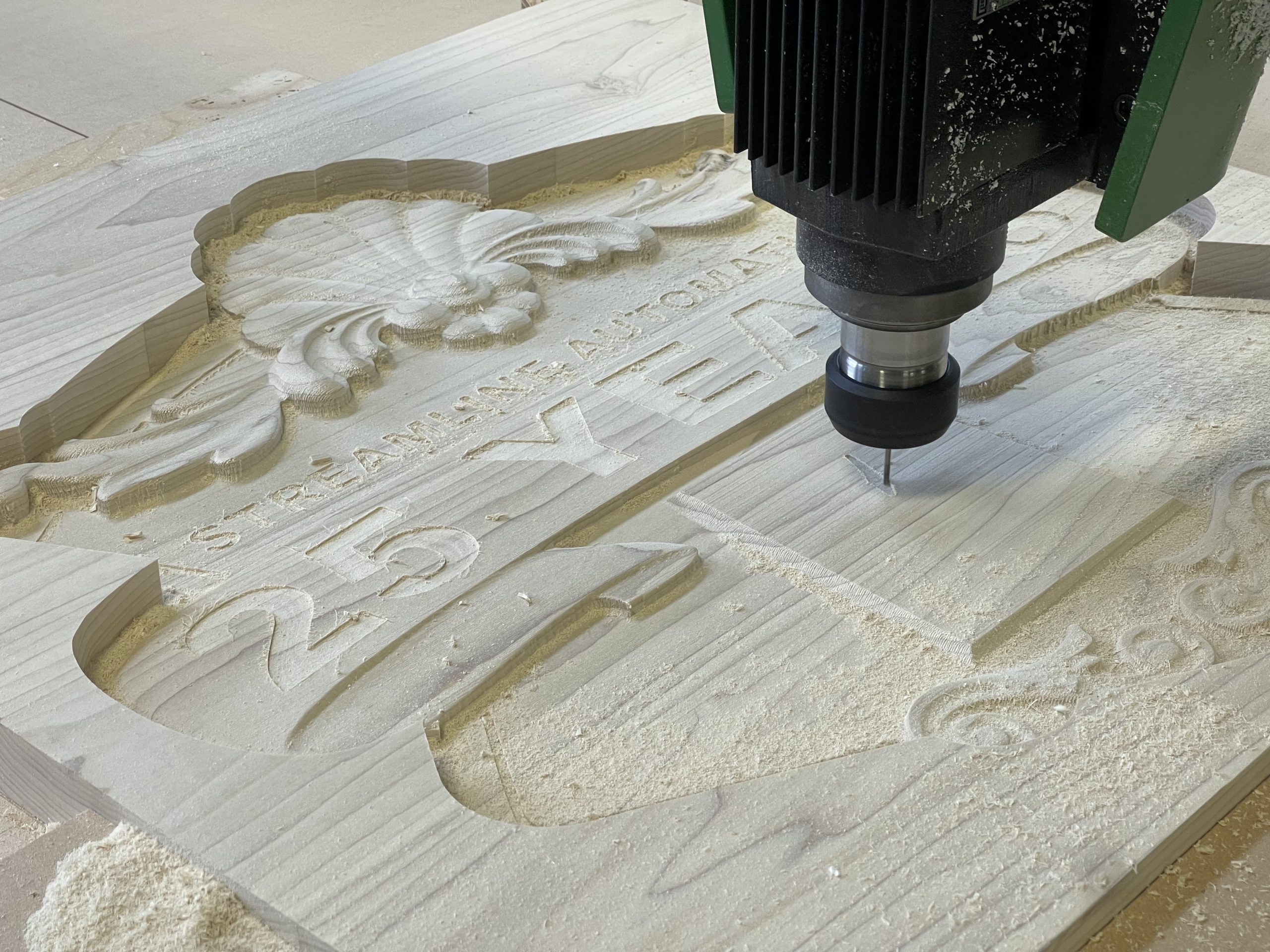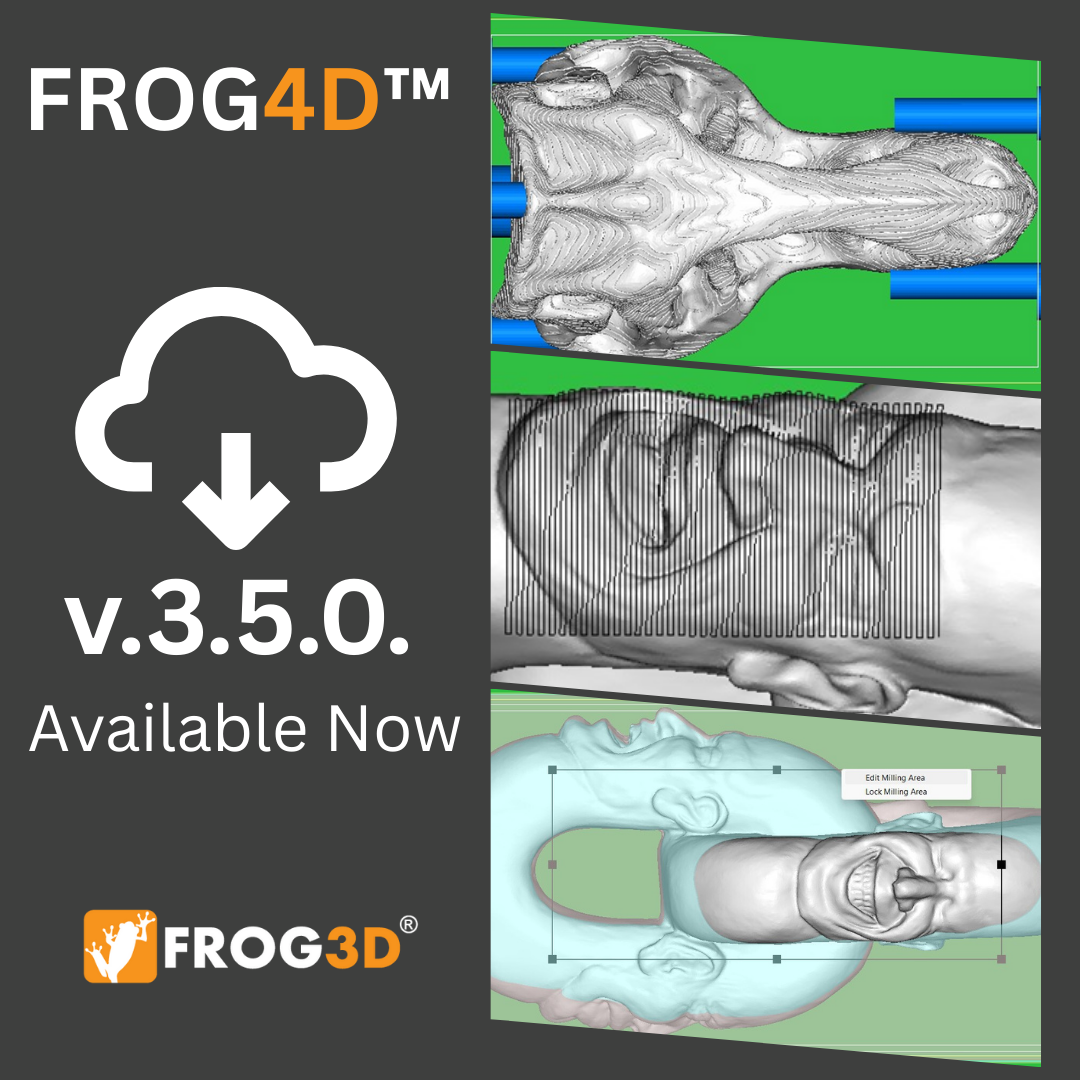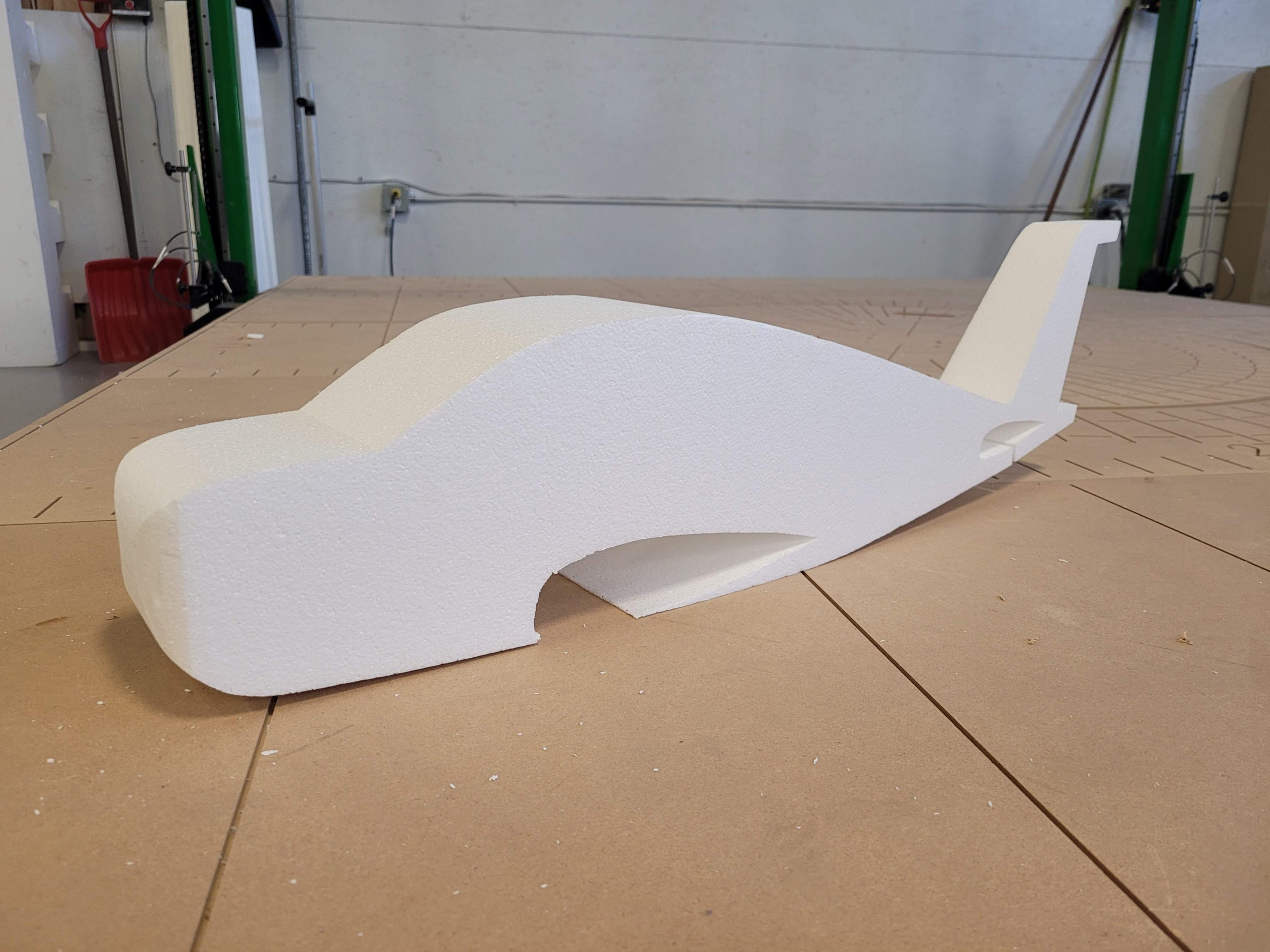Have you ever wondered how that impressive lobby display with the 15’ tall statue was built, or how the mesmerizing and larger-than-life character displays were created at an amusement park? 3D fabrication involves sculpting, carving, special finishes and coatings to build such impressive and unique models. In addition to themed environments, trade show displays, and architectural elements, 3D fabrication is used in various fields such as prototyping, manufacturing, medical, and aerospace among several other industries. 3D foam fabrication can be used to create all kinds of shapes, letters, props, and characters – you just merely think of an idea and it can be made possible with the right technology and processes!
Accessible digital fabrication tools connect the gap between design and manufacturing. 3D foam fabrication is a swiftly evolving field that bridges the principles of additive manufacturing with traditional sculpting techniques to produce detailed and large-scale foam models and prototypes. In this guide, we delve into the technology, processes, and tools involved in 3D fabrication processes to create stunning end products with foam.
Table of Contents
What Is 3D Foam Fabrication?
3D fabrication utilizing foam involves the creation of three-dimensional objects using foam materials, and this method is popular in industries where versatility is essential such as film and television, architecture, themed environments, and prototyping due to its cost-effectiveness and dexterity. Foam offers the benefits of being lightweight, economical, and efficient considering fabrication timelines where custom shapes can be created to execute any type of imagination. The 3D foam fabrication process begins with a digital model which is then brought to fruition using various fabrication techniques.
Technology Used in 3D Fabrication Of Foam
The following are the primary technologies involved behind 3D foam fabrication:
- CAD Software: Computer Aided Design (CAD) software is utilized to design detailed models and prototypes, where programs such as AutoCAD and SolidWorks enable designers to create complex shapes and forms that can be reproduced accurately in foam.
- CAM Software: Computer Aided Manufacturing (CAM) converts the CAD designs into instructions for the fabrication tools and equipment, and this software ensures that the cutting, milling, or carving tools follow the accurate paths required to recreate the digital model in foam.
- CNC Machines: Computer Numerical Control (CNC) machines are central to foam fabrication. These machines include routers, and hot wire cutters that are controlled by CAM software to accurately cut and shape the foam according to the digital design.
The 3D Foam Fabrication Process
3D fabrication is a process requiring several steps to transform digital designs into physical foam models or prototypes which involves the use of advanced technology and specialized tools to guarantee precision and efficiency. The following steps outline the process of 3D foam fabrication:
Digital Design
The 3D fabrication process starts with the creation of a digital model using CAD software, and this model may be based on a concept, a physical object, or even a 3D scan. The design includes all necessary geometrical and dimensional information for the CNC machine to follow.
Toolpath Generation
Once the CAD design is finalized, CAM software is used to generate toolpaths to guide specific movements for the fabrication machine to follow in creating the 3D object. Toolpath generation takes into consideration the type of tools and cutting strategies such as cutting, carving, or milling that will be used to create the final piece.
Material Selection
In 3D foam fabrication processes, the appropriate type of foam is selected based on project requirements. Some common varieties of foam include polystyrene, polyurethane, and polyethylene. It is important to select the type of foam based on factors such as density, strength, and finishing requirements.
Machining And Fabrication
Following the above steps, foam is placed in the CNC machine and the toolpaths are loaded, after which the machine cuts, mills, or carves the foam according to the design parameters.
Finishing
After the initial fabrication steps are completed, the 3D foam object may require additional finishing touches such as sanding, coating, or painting to achieve the intended look and feel.
Tools And Equipment Involved In 3D Foam Fabrication
There are several tools and equipment that are essential for effective 3D fabrication of foam materials:
- CNC Routers: These are versatile machines that are capable of cutting and shaping foam with utmost precision and are ideal for creating complex designs and large-scale models.
- Hot Wire Cutters: Hot wire cutters utilize a heated wire to slice through foam which makes them perfect for obtaining smooth and straight cuts with curves.
- Milling Machines: These utilize rotary cutters to extract material from the foam to allow the creation of complex shapes and detailed features.
- Foam Coating Systems: Foam coating systems provide the ability to apply protective and decorative coatings to foam models to enhance their durability and appearance.
Applications Of 3D Fabrication
Foam sculpting is one of the most popular mediums for sculpting as it produces mesmerizing sculptures quickly and cost effectively. Foam sculptures are popular in a wide range of applications from trade shows, museums, theme parks, retail stores, and office complexes to lobby displays, faux landscapes, special events, and so much more. They provide realistic, awe-inspiring physical models of original designs and various industries benefit from 3D foam fabrication such as the following:
Film And Television
3D fabrication is typically used in the entertainment industry to produce props, set pieces, and special effects that would otherwise be too expensive or impractical to build with traditional materials and processes. Foam can be carved and detailed to build unique and custom props for scenes, and scale models of larger sets or objects can be made from foam for special effects shots or detailed scenes.
Architecture
3D foam fabrication is gaining traction in the field of architecture, as it offers a range of benefits that improve design flexibility, reduce costs, and speed up construction processes. Foam is used to produce detailed scale models of buildings and urban designs, and this allows architects to visualize and communicate their ideas effectively. In addition, foam can be carved into unique and intricate designs for cornices, moldings, columns, and other decorative architectural elements, where custom facade panels and cladding can also be created from foam which offer unique textures and patterns.
Themed Environments
3D fabrication of foam has the ability to create immersive landscapes and set pieces in themed environments which enhance the thematic experience of rides in amusement parks. For example, iconic attractions at Disneyland and Disney World use foam fabrication processes and technology, along with the Wizarding World of Harry Potter and Jurassic Park which feature 3D foam-fabricated environments to create unique, immersive and memorable spaces.
Prototyping
Foam is used to develop initial concept models of new products to allow designers to visualize and refine their ideas before production. This allows for rapid iteration and testing which reduces the time and cost associated with manual prototyping methods. 3D foam fabrication techniques can be used to create prototypes that test the functionality and ergonomics of a product before its mass production. Prototyping is common in industries such as Aerospace, Marine, Automotive, and many others.
Advantages Of 3D Foam Fabrication
3D fabrication presents numerous benefits across multiple industries, establishing it as a favored technique for developing models, prototypes, and finished products out of foam. The following are some of its key advantages:
- Cost-Effectiveness: Foam is inexpensive which makes it a cost-effective choice for large-scale 3D models and prototypes.
- Lightweight: Foam is a lightweight material, which makes final products fabricated from foam easy to handle and transport, which is advantageous for large-scale projects.
- Versatility: 3D foam fabrication allows foam to be easily cut, shaped, and finished to facilitate a wide range of designs and textures.
- Precision: 3D fabrication of foam enables the seamless production of intricate products, delivering high precision even with unique, complex features and tight tolerances.
Mastering 3D Fabrication With Streamline Automation’s FROG3D® System
FROGScan™ Flash - Peel 3
FROGScan™ Flash – Peel 3 is an advanced 3D scanning system which utilizes structured light technology to capture highly detailed and accurate digital representations of physical objects to facilitate 3D fabrication processes. This technology plays a crucial role in the foam fabrication workflow by providing precise measurements and high-resolution 3D models that serve as the foundation for creating intricate foam sculptures and prototypes. With its rapid capture and real-time processing capabilities, FROGScan™ Flash – Peel 3 streamlines the sequence by reducing the time and effort required to digitize and replicate complex designs. The FROGScan™ Flash – Peel 3 integrates seamlessly with other FROG3D® system components such as the FROGMill™ CNC milling machine and the FROGWire™ hot wire cutter to ensure that every step from scanning to final fabrication is executed with unparalleled precision and efficiency, ultimately enhancing the quality and consistency of 3D foam-fabricated products.
FROGShape™
Streamline Automation’s FROGShape™ software facilitates 3D fabrication processes by seamlessly integrating with the FROGWire™ CNC hot wire cutting system. This powerful combination allows users to create detailed 3D models and generate precise toolpaths specifically tailored for foam cutting. The FROGShape™ optimizes the cutting sequences for cutting, and ensures that the FROGWire™ executes each cut with high accuracy and efficiency. The software’s ability to simulate the cutting process enables users to identify and resolve potential issues before production begins, and this feature reduces material waste and enhances overall workflow efficiency. By working in tandem, FROGShape™ and FROGWire™ streamline the transition from digital design to physical fabrication, ensuring consistent, high-quality results in 3D foam projects..
FROGMill™
The FROGMill™ is FROG3D®’s advanced CNC milling machine, equipped with comprehensive software and an efficient dust collection system. As the industry’s most versatile 4-axis CNC foam carving router, it offers capabilities far beyond those of traditional processes or standard machines. When integrated with the FROG3D® System, FROGMill™ streamlines the conversion from product design to manufacturing, delivering your 3D fabrication ideas with unmatched precision and efficiency.
The FROGMill™ is engineered to enhance precision and speed in 3D foam fabrication, and excels at creating foam products such as sculptures, models, replicas, prototypes, molds, precast products and so much more tailored to meet your manufacturing needs. It swiftly produces products to exact dimensions and shapes, thus providing increased flexibility in design and production which will enable fuss-free exploration of new product lines. The FROGMill™ ensures consistency and repeatability as it repeats programmed designs accurately each time which guarantees uniformity in products. Its precise cutting capabilities minimize foam and resource waste, thus offering significant cost savings for any business while maintaining high standards of quality.
FROGWire™
The FROGWire™ is a fully automated CNC cutter designed to elevate the precision and efficiency of 3D fabrication of foam. By being computer-driven, it ensures the accuracy and repeatability of every contour and cut, thus eliminating the risks of operational dangers, human errors, and slow turnovers associated with manual cutters. As an essential part of the FROG3D® System, the FROGWire™ prepares foam materials for milling with the FROGMill™ and enables in-house processing without the need for pre-slab or shaping services.
With its user-friendly controller system, the FROGWire™ simplifies the hot wire cutting process required for the 3D fabrication process. 2D and 3D model design files are imported directly into the industrial-grade G-code-based controller, which automatically provides the machine with the necessary toolpaths. The FROGWire™ can be equipped with dual wires, enabling immediate double throughput and reducing production time by replicating cutting functions simultaneously on the same machine. Additionally, its multi-axis capabilities which include a rotational axis facilitate the cutting and forming of complex structures which enhances the precision and reduces the operation time and cost of 3D foam fabrication.
FROGTools™
Engineered to integrate seamlessly with the FROGMill™, each tool in the FROGTools™ lineup is optimized for various aspects of foam cutting, carving, and detailing involved in 3D fabrication of foam. This ensures that fabricators achieve the desired results with maximum efficiency and accuracy. Carving tools can be used to add detailed textures, patterns, and fine details, and milling tools can create complex shapes and contours and are essential tools for creating detailed and three-dimensional features. FROGTools™ provide the ideal solution for precise and efficient 3D foam fabrication.
FROGSkin™ By Graco
FROGSkin™ by Graco is a plural component spray system suited for 3D foam fabrication to apply hard coat to machined foam with precision. This system applies thick layers of polyurethane coating that typically harden within seconds, providing a faster and more efficient alternative to traditional brush-on epoxies and resins which can be runny, require multiple coats, and take hours to cure. The polyurethane coatings offered by FROGSkin™ by Graco are particularly time-saving for large CNC sculptural pieces.
FROGSkin™ by Graco features advanced mixing, pumping, and dispensing technologies, making it the ultimate solution for applying durable, smooth, or textured finishes to 3D fabrication of foam sculptures. When combined with the FROGCoat™ line of coatings, FROGSkin™ by Graco offers an unparalleled coating solution for a variety of 3D foam applications. This electric spray system is ideal for applying polyurea and other protective coatings, ensuring that CNC foam sculptures receive robust and weather-resistant finishes. The coatings are waterproof, UV-stable, and capable of withstanding harsh environments including snow and rain which enhances the durability and longevity of 3D fabricated foam pieces.
Conclusion
Bring your digital designs to life with the right technology and tools for creating detailed and large-scale models and prototypes with Streamline Automation’s FROG3D® System. Our professionals can help you fully realize the capabilities of modern foam fabrication and offer a comprehensive and resource-saving solution that streamlines the entire process from digital design to finishing. Contact us today to get started!



